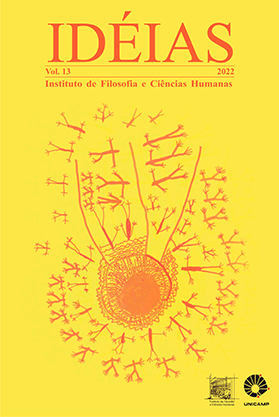Abstract
With the growing popularity of artificial intelligence techniques, questions about the capabilities and limitations of these technologies gain notoriety. This work proposes that, as contemporary forms of automatism, these technologies share similarities with those analyzed by Gilbert Simondon’s philosophy of technique. It also proposes that therefore his thought is of great value to reflect on them. Developing mainly from “Complementary note on the consequences of the notion of individuation”, and taking artificial neural network as an example algorithm, the article presents three moments when artificial intelligence would express limitations in relation to its structure that was fixed by its inventor. These limitations are in the input data, in the training of the model and in the final representation of the knowledge allegedly learned. The article concludes with a brief analysis on the consequences of extensive use of AI technologies in the light of the limitations presented.
References
ANGWIN, J. et al. Machine Bias: There’s software used across the country to predict future criminals. And it’s biased against blacks. ProPublica, 23 maio 2016. Disponível em: https://www.propublica.org/article/machine-bias-risk-assessments-in-criminal-sentencing. Acesso em: 21 abr. 2022.
CRAWFORD, K.; PAGLEN, T. Excavating AI: The politics of images in machine learning training sets. The AI Now Institute, NYU, 19 set. 2019. Disponível em: https://excavating.ai/. Acesso em: 21 abr. 2022.
ELISH, M. C.; BOYD, DANAH. Situating methods in the magic of Big Data and AI. Communication Monographs, v. 85, n. 1, p. 57–80, 2 jan. 2018.
GOODFELLOW, I.; BENGIO, Y.; COURVILLE, A. Deep Learning. [s.l.] MIT Press, 2016. Disponível em: https://www.deeplearningbook.org/. Acesso em: 21 abr. 2022.
LECUN, Y.; BENGIO, Y.; HINTON, G. Deep learning. Nature, v. 521, n. 7553, p. 436–444, maio 2015.
PASQUINELLI, M.; JOLER, V. The Nooscope manifested: artificial intelligence as instrument of knowledge extractivism. AI & SOCIETY, v. 36, n. 4, p. 1263–1280, 2021.
PRATES, M. O. R.; AVELAR, P. H.; LAMB, L. C. Assessing gender bias in machine translation: a case study with Google Translate. Neural Computing and Applications, v. 32, n. 10, p. 6363–6381, maio 2020.
ROUVROY, A.; BERNS, T. Governamentalidade algorítmica e perspectivas de emancipação: o díspar como condição de individuação pela relação? Revista ECO-Pós, v. 18, n. 2, p. 36–56, 2015.
SEARLE, J. R. Minds, brains, and programs. Behavioral and Brain Sciences, v. 3, n. 3, p. 417–424, 1980.
SILVA, T. Racismo algorítmico em plataformas digitais: microagressões e discriminação em código. In: SILVA, T. (Org.). Comunidades, algoritmos e ativismos digitais: Olhares afrodiaspóricos. 1. ed. São Paulo: LiteraRUA, 2020. p. 121–137.
SIMONDON, G. Do modo de existência dos objetos técnicos. Tradução: Vera Ribeiro. 1. ed. Rio de Janeiro: Editora Contraponto, 2020a.
SIMONDON, G. Nota complementar sobre as consequências da noção de individuação. In: A individuação à luz das noções de forma e de informação. Tradução: Luís Eduardo Ponciano Aragon; Tradução: Guilherme Ivo. 1. ed. São Paulo: Editora 34, 2020b. p. 507–545.
TURING, A. M. I.—COMPUTING MACHINERY AND INTELLIGENCE. Mind, v. LIX, n. 236, p. 433–460, out. 1950.

This work is licensed under a Creative Commons Attribution-NonCommercial-ShareAlike 4.0 International License.
Copyright (c) 2022 Ideias


